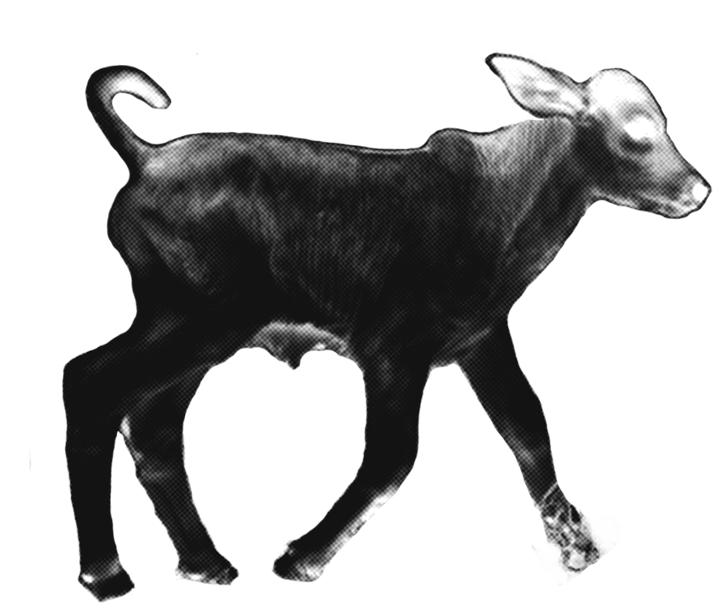La escultura es el regazo del encuentro
Mi trabajo escultórico germina a partir de observar las relaciones inherentes entre los humanos y los seres de la tierra. La forma en que la mano deja caer una semilla en un agujero hecho en un surco de tierra y luego, la forma en que se desentierra el alimento. Las abejas cubriendo con cera las celdas para preservar la miel, y la miel endulzando un sorbo de té. Jardines de hongos labrados por termitas, y cientos de termiteros sobre cultivos labrados por humanos. Una vaca buscando mazorcas días después de la cosecha en el sembradío y una ternera alimentándose con la leche de su madre, desde un biberón entre la neblina y el frío.
Intento transformar mi condición humana a través de la atención en otras formas posibles de generar encuentros y tejer vínculos con los seres de la tierra, en la que pueda poner en tensión la relación de dominio que se suele establecer por medio de prácticas como la ganadería.
La transformación de la materia es la extensión de una intención y la escultura es su testigo. Cuando la intención busca invocar y convocar a otros seres, la escultura acontece en regazo, un regazo para que repose el encuentro.
El paisaje que señala lo cotidiano como sagrado
Las distintas maneras en que interactúan los diversos elementos que constituyen el planeta fundan imágenes, esas imágenes son paisajes. Entonces, un paisaje no es un retablo de dos dimensiones que funciona como mirilla, tampoco es la frontera que impone el rectángulo de una pintura.
Desde la frente de alguien que recibe el sol, una gota de sudor se vierte al viento para tocar el suelo. Una res se acuesta sobre la hierba y mientras anochece, mueve su cola para espantar las moscas. Un humano atrapa con sutileza una pequeña ave que se ha metido por la ventana de su casa, para indicarle donde puede restablecer su vuelo.
Un paisaje ocurre cuando se dispone un espacio para escuchar y señalar un lugar, sus elementos y su expresión material. El paisaje, además de ser un concepto cultural o ecológico, insinúa las relaciones, experiencias y afectos entre los seres de la tierra y revela los puntos de contacto entre las divergencias. La escultura atestigua los procesos vitales que suceden al estar en relacionamiento con el pluriverso, y permanecerá incluso hasta cuando la sangre se convierta en polen.
(ENG)
Sculpture as a Cradle of Encounter
My sculptural work germinates from observing the inherent relationships between humans and earth beings. The way the hand drops a seed into a hole made in a furrow of earth, and then the way the food is dug up.
Bees covering cells with wax to preserve honey, and honey sweetening a sip of tea. Mushroom gardens tilled by termites, and hundreds of termite mounds on crops tilled by humans. A cow foraging for ears of corn days after harvest in the field, and a calf feeding on its mother's milk from a bottle amid the mist and cold.
I try to transform my human condition through paying attention to other possible ways of generating encounters and weaving links with earth beings, challenging the relationship of domination usually established through practices such as cattle raising.
The transformation of matter is the extension of an intention, and sculpture stands as its witness. When that intention seeks to invoke and invite other beings, sculpture becomes a cradle—a cradle for the encounter to rest on.
A Landscape That Makes the Everyday Sacred
The diverse ways in which the elements that make up the planet interact create images; these images are landscapes. Therefore, a landscape is not a two-dimensional tableau that functions as a peephole, nor is it the border imposed by the rectangle of a painting.
From the forehead of someone who receives the sun, a drop of sweat pours into the wind to touch the ground. A cow lies down on the grass, and while it gets dark, it moves its tail to scare away the flies. A human gently catches a small bird that has climbed through the window into his house to guide it where it can resume its flight.
A landscape occurs when a space is arranged to listen and point out a place, its elements and its material expression.
Beyond a cultural or ecological concept, landscape evokes the relationships, experiences, and affections between beings of the earth, illuminating points of connection amid divergence. I believe sculpture will bear witness to the life-giving processes that occur in being in relationship with the pluriverse, and that it will endure even until blood becomes pollen.
